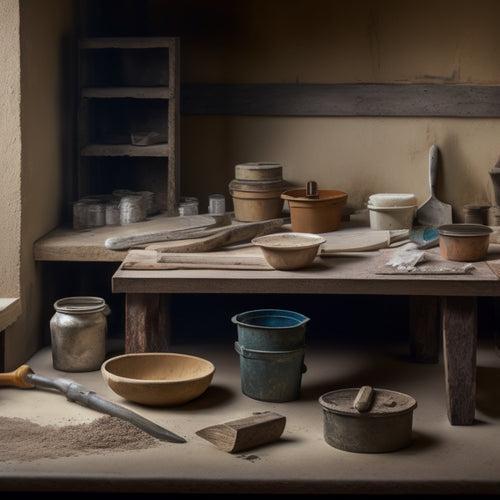
What to Look for in Pneumatic Renovation Tools
Share
When selecting pneumatic renovation tools, you'll want to take into account several key factors to guarantee optimal performance, safety, and durability. Look for tools built with high-quality materials, durable seals, and adherence to industry standards for reliability. Evaluating air pressure and flow rate requirements, as well as noise level and vibration control, is vital for efficient and comfortable operation. Ergonomic design, versatility, and safety features like built-in safety valves and emergency shut-off capabilities are also fundamental. Additionally, take into account maintenance and repair requirements, including regular checks and the availability of repair kits. By examining these factors, you'll be well-equipped to make an informed decision that meets your specific needs.
Key Takeaways
- Look for durable materials, robust design, and adherence to industry standards to ensure tool reliability in harsh renovation environments.
- Ensure tools match compressor capabilities and have built-in pressure regulators to control air pressure and flow rate for optimal performance.
- Consider noise reduction technologies, vibration dampening mechanisms, and ergonomic design features to minimize user discomfort and fatigue.
- Opt for versatile tools with multi-tool functionality, compatibility with accessories, and application-specific features to tackle various renovation tasks efficiently.
- Check for safety features, maintenance requirements, and repair kit availability to ensure safe and efficient tool operation with minimal downtime.
Tool Durability and Build Quality
When selecting pneumatic renovation tools, you expect a certain level of durability and build quality to withstand the rigors of your projects. You need tools that can handle the demands of heavy use, harsh environments, and repetitive tasks.
To guarantee this, manufacturers focus on material selection and design standards.
The choice of materials greatly impacts tool durability. Look for tools made from high-quality, heavy-duty materials that can resist wear and tear. For example, steel or aluminum bodies can withstand the rigors of construction sites, while durable seals and O-rings can maintain air pressure and prevent leaks.
Design standards also play a critical role in tool durability. Manufacturers should adhere to industry-recognized standards for design, testing, and quality control. This guarantees that tools are built to withstand the demands of your projects and minimize the risk of failure.
Air Pressure and Flow Rate
Air pressure and flow rate are vital specifications to evaluate when selecting pneumatic renovation tools.
You'll want to guarantee the tool you choose is compatible with your air compressor and can handle the required pressure and flow rate for peak performance. Check the tool's specifications to verify it matches your compressor's capabilities. A tool that requires higher pressure or flow rate than your compressor can provide will underperform or even damage the compressor.
Pressure regulation is also essential, as it allows you to adjust the air pressure to suit the task at hand. Look for tools with built-in pressure regulators or consider purchasing a separate regulator to provide precise control over air pressure. This feature is particularly important when working with delicate materials or in applications where excessive pressure could cause damage.
When evaluating air pressure and flow rate, consider the specific requirements of your projects.
Will you be working with heavy materials or in applications that demand high torque? If so, you'll need a tool that can handle higher pressure and flow rates. By carefully evaluating these specifications, you'll be able to choose the right pneumatic renovation tool for your needs.
Noise Level and Vibration Control
Tool operators often find themselves battling fatigue and discomfort due to excessive noise and vibration from pneumatic renovation tools.
You'll want to look for tools that incorporate noise reduction technologies to minimize the decibel level. Some manufacturers have developed innovative solutions, such as mufflers or sound-absorbing materials, to reduce the noise output.
Additionally, vibration dampening mechanisms can greatly reduce the amount of vibration transmitted to your hands, making the tool more comfortable to use.
When evaluating a tool's noise level and vibration control, take into account the decibel rating and look for features like vibration-isolating handles or anti-vibration mounts.
These features can make a considerable difference in reducing operator fatigue and improving overall productivity.
You may also want to think about tools with adjustable exhausts, which can direct the air away from your body, further reducing noise and vibration.
Ergonomic Design and Handling
Proper ergonomics play an essential role in reducing operator fatigue and discomfort, allowing you to work more efficiently and safely. When choosing pneumatic renovation tools, consider the design and handling features that promote user comfort.
A well-designed tool should fit comfortably in your hand, reducing strain on your muscles and joints.
Here are three key factors to look for:
-
Balanced tool weight: Look for tools with balanced weight distribution, making them easier to maneuver and reducing fatigue.
-
Contoured grips: Tools with contoured grips provide a secure hold, even with gloved hands, and help to reduce slippage.
-
Ergonomic handle angles: Handles with ergonomic angles reduce strain on your wrist and hand, allowing you to work for extended periods without discomfort.
Versatility and Multi-Functionality
You'll find that pneumatic renovation tools excel in versatility, allowing you to tackle a wide range of applications with a single tool.
With the ability to handle multiple tasks, you can complete projects more efficiently, reducing the need for multiple tool changes.
This multi-functionality also enables you to adapt to unexpected challenges, making you a more effective renovator.
Tool Application Variety
Pneumatic renovation tools excel in versatility, offering a wide range of applications that cater to diverse project needs.
When it comes to tool application variety, you'll appreciate the flexibility to tackle various tasks with a single tool. This versatility not only saves you time and money but also enhances your overall user experience.
Here are three key aspects of tool application variety to evaluate:
-
Multi-tool functionality: Look for tools that can perform multiple functions, such as drilling, driving, and fastening, to reduce the need for multiple tools on site.
-
Tool compatibility: Verify the tool is compatible with various accessories and attachments, allowing you to adapt to different tasks and materials with ease.
-
Application-specific features: Reflect on tools with features specifically designed for your project's unique requirements, such as drywall installation or concrete drilling.
Multiple Tasks Handled
With a single tool handling multiple tasks, you're enabled to work more efficiently and effectively. This versatility is vital in renovation projects, where time is of the essence and task efficiency is paramount.
When evaluating pneumatic renovation tools, look for those that can perform multiple functions, such as drilling, driving, and fastening. This multi-functionality allows you to complete tasks quickly and seamlessly, reducing the need for multiple tool changes and minimizing downtime.
Tool compatibility is also significant in this regard. Verify that the tool you choose is compatible with a range of accessories and attachments, enabling you to adapt to different tasks and applications with ease.
This flexibility is particularly important in renovation projects, where unexpected challenges often arise. By investing in a versatile and multi-functional pneumatic renovation tool, you can tackle a variety of tasks with confidence, optimizing your workflow and achieving greater task efficiency.
Safety Features and Precautions
Frequently, accidents occur when operators fail to follow proper safety protocols, highlighting the importance of understanding the safety features and precautions associated with pneumatic renovation tools.
You must guarantee that you're familiar with the safety standards and guidelines relevant to your tools and work environment. This includes understanding the manufacturer's guidelines, industry regulations, and local laws.
When selecting pneumatic renovation tools, look for the following safety features:
- Safety valves: Confirm that the tools have built-in safety valves that prevent accidental start-ups or over-pressurization.
- Insulation and guarding: Check that the tools have adequate insulation and guarding to prevent electrical shock, heat burns, or entanglement risks.
- Emergency shut-off: Verify that the tools have an easily accessible emergency shut-off feature, allowing you to quickly stop the tool in case of an emergency.
Maintenance and Repair Requirements
Your toolkit is only as reliable as its maintenance schedule. Regular checks and servicing can prevent downtime, reduce repair costs, and guarantee peak performance.
When evaluating pneumatic renovation tools, look for manufacturers that provide detailed maintenance schedules and guidelines. A well-structured maintenance plan should include routine tasks such as cleaning, lubricating, and replacing worn or damaged parts.
In addition to maintenance, consider the availability and cost of repair kits. A thorough repair kit should include replacement parts, such as o-rings, seals, and valves, as well as detailed instructions for DIY repairs. This can help minimize downtime and reduce reliance on external repair services.
When evaluating repair kits, look for kits that are specifically designed for your tool model and include genuine manufacturer parts. By prioritizing maintenance and having a reliable repair kit on hand, you can guarantee your pneumatic renovation tools are always ready for the job.
Frequently Asked Questions
Can Pneumatic Renovation Tools Be Used in Explosive Environments?
When working in explosive environments, you'll need to take extra precautions; pneumatic renovation tools can be used, but you must verify they're designed with safety precautions and explosion-proof features to minimize risks and prevent catastrophic accidents.
Do Pneumatic Tools Require Regular Lubrication for Optimal Performance?
You'll be surprised to know that 75% of pneumatic tool failures are due to inadequate lubrication. To avoid this, you'll need to regularly apply the right lubrication types, such as silicone or petroleum-based oils, according to the manufacturer's maintenance schedules.
Are Pneumatic Renovation Tools Compatible With All Air Compressors?
You'll find that not all pneumatic renovation tools are compatible with every air compressor, as different tool types require specific air flow rates and pressures, so verify you match your tool to an air compressor with compatible specifications.
Can Pneumatic Tools Be Used in Extreme Temperature Conditions?
You've heard that pneumatic tools can't handle extreme temperatures, but is that true? In reality, you'll find that temperature impact affects tool durability, with some models thriving in freezing or scorching conditions, while others falter.
Are Pneumatic Renovation Tools Suitable for Left-Handed Users?
When choosing pneumatic renovation tools, you'll want to guarantee they cater to your left-handed needs. Look for tools with ambidextrous designs, ergonomic grips, and accessible controls that don't compromise tool accessibility, allowing you to work efficiently and comfortably.
Conclusion
"Crafting a cohesive renovation requires careful consideration of pneumatic tools' essential characteristics. By scrutinizing durability, air pressure, noise levels, ergonomics, versatility, safety features, and maintenance needs, you'll construct a well-rounded arsenal. Remember, precision and proficiency pivot on the perfect pairing of tool and task. Pursue a melody of silky-smooth operation, pinpoint performance, and prolonged productivity – the perfect harmony for your renovation rhythm."
Related Posts
-

Create a Home Renovation Project Timeline in Excel
You can create a detailed home renovation project timeline in Excel by setting up a tailored template with separate w...
-

Top 5 Plastering Tools for Small Renovation Jobs
For small renovation jobs, you'll want to start with the top 5 crucial plastering tools: a putty knife for applying a...
-

Streamline Your Exterior Renovation Timeline
To streamline your exterior renovation timeline, you'll need to approach the process strategically. Start by planning...


